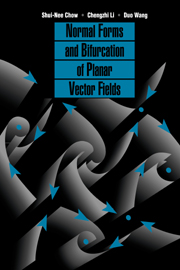Preface
Published online by Cambridge University Press: 25 March 2010
Summary
The theory of bifurcation of vector fields is the study of a family of equations that are close to a given equation. For example, the family of equations could be a system of vector fields depending on several parameters. An important problem is to understand how the topological structure of the flow generated by the family of vector fields changes qualitatively as parameters are varied. The main purpose of this book is to present some methods and results of the theory of bifurcations of planar vector fields.
Since simplifying equations is often a necessary first step in many bifurcation problems, we introduce the theory of center manifolds and the theory of normal forms. Center manifold theory is important for the reduction of equations to ones of lower dimension, and normal-form theory gives a tool for simplifying the forms of equations to the ones with the simplest possible higher-order terms near their equilibria. We introduce versal deformations of vector fields and define the codimension of a bifurcation of vector fields. This is illustrated by saddle-node and Hopf bifurcations. We discuss in detail all known codimension-two bifurcations of planar vector fields. Some special cases of higher-codimension bifurcations are also considered.
In Chapter 1, we introduce briefly the basic concepts of center manifolds. We show the existence, uniqueness, and smoothness of global center manifolds. The existence, asymptotic behavior, and foliation of local center manifolds are also discussed.
In Chapter 2, we present the theory of normal forms. We first discuss in detail normal forms of vector fields near their equilibria. We introduce two methods for computing normal forms: the matrix representation method and the method of adjoints.
Information
- Type
- Chapter
- Information
- Normal Forms and Bifurcation of Planar Vector Fields , pp. vii - viiiPublisher: Cambridge University PressPrint publication year: 1994
